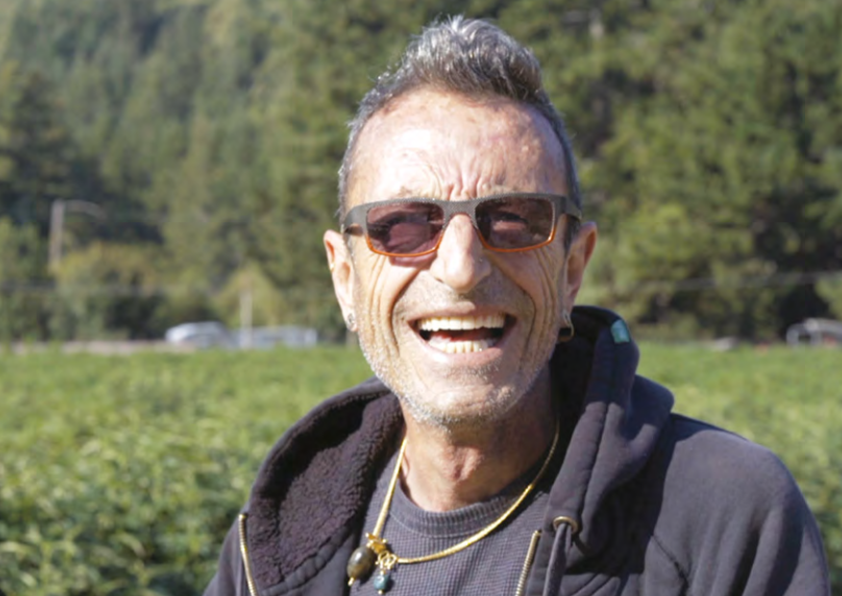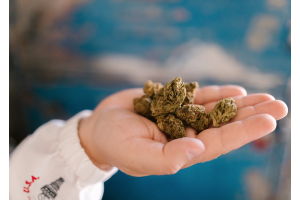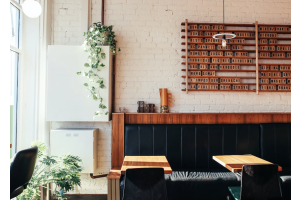The Making of Frenchy Dreams of Hashin, A Documentary Film By Jake Remington

“The way we treat that plant, the way we work with it, will define the future.” - Frenchy Cannoli
Frenchy Dreams of Hashish was born from seeds planted long ago. A few germinated in the 1980s when Frenchy first climbed the mountainous trails of Himachal Pradesh, high in the Indian Himalayas, walking days from the nearest village to reach the elusive altitudes where the wild cannabis plants grew. He planned to turn those native plants into the hand-rubbed cannabis concentrate called charas. The finest quality charas was made from the plants that grew in this terroir, benefitting from the ultra-intense UV ray exposure that encouraged optimum trichome head formation. Other seeds were sown during his many visits to Tokyo, where I attended university.
Visiting museums, studying antiques with a local Japanese dealer, and learning about the traditional Japanese craftsperson's obsessive focus on quality encouraged his drive toward excellence. According to Japanese tradition, mastery requires 60,000 hours (30 years) of practice. Frenchy was always obsessed with making the best hashish. And, at that point, he had only just begun.40 years later, when Frenchy first started making the rounds of the cannabis cups in California, a middle-aged French guy in brightly patterned pants drew a lot of attention. People would approach him to ask what he did in the cannabis space. "I'm a hashishin, a hash-maker." he'd explain in his incomprehensible thick accent.
The word had no meaning for most. Their confusion was understandable since many had been born after the 1980s. At that point, the FEDS had incarcerated the major smugglers from the Hippie Era of the 1960s, the members of the Brotherhood of Eternal Love, and others involved with the flow of traditional hashish from Afghanistan, Lebanon, and other producing countries to the U.S. The U.S. government's War on Drugs had been very successful at destroying the pipeline, and now there was a whole generation of cannabis consumers needing education on the culture of hashish. Frenchy, multi-hose hookah in hand, was ready to provide it. Frenchy used to observe that North America, separated from Europe by the Atlantic, was like a large island regarding cannabis consumption, for some reason seeing only the flower.
Europeans, on the other hand, were united by a land mass that had allowed continuous trade to flow overland from the birthplace of cannabis in Northern Tibet 28 million years ago1, along the Silk Road, through the Fertile Crescent, and ultimately with Napoleon's returning troops from Egypt into France and other parts of Europe bringing traditional pressed hashish to consumers there. Knowing that when it comes to cannabis concentrates, smoking will tell you more than your eyes, Frenchy made it his mission to "smoke everyone out," as he affectionately referred to the process of turning someone on to the experience of traditional pressed hashish for the first time. A hashish renaissance was underway, and Frenchy was the Pied Piper. This ultimately led to people asking him to teach them how to make hashish since many were already growing cannabis plants legally under the protection of the Prop 215 Medical Marijuana Initiative in California from 1996-2016. Frenchy started answering DIY questions on a RollitUp forum the famed breeder Sub-cool created for him in 2013 and began in-person workshops in 2015.
A phone call Frenchy received during a long drive north on Hwy 101 from the SF Bay Area to Humboldt, through the heart of the famed Emerald Triangle, cemented his plans to make a series of DIY hash-making videos. A young person from Lebanon, whose family had once been traditional hashish producers called Frenchy, after connecting on Instagram during this road trip to ask for pointers to finetune his modern hash-making process. Over the generations, some details had been lost, some processing logic forgotten, and Frenchy could explain "the science behind" the methodology as he drove north to visit his beloved farmers. Back home a few days later, he recounted the experience, visibly touched to have been able to return, in a sense, the knowledge given to him as a 'clueless youth wandering the world' during the 18 years he studied along traditional hash-makers in producing countries. Frenchy relished the opportunity to "pass on the traditions," as he called it.
We just needed a filmmaker. A fortuitous encounter paved our introduction to our future filmmaker, Jake Remington. At the time, our daughter was an artist based in New York City. Artists tend to know artists, so we asked her if she knew any talented young filmmakers to introduce us to. Her soon-to-be boyfriend of the epoch, a drummer in a music video she was dancing in, introduced her to Jake. A large cannabis event was happening the next week, and Frenchy was scheduled to do a workshop, so we agreed to meet in Barcelona for Spannabis. A cannabis conference with Frenchy is a baptism-by-fire introduction to the close-knit cannabis community and a marathon at a sprint's pace. In Barcelona, with its hundreds of cannabis social clubs, the trip became a frenetic series of cannabis cup-judging events, full-day workshops, and social club hopping.After Barcelona, solo filming with Frenchy was arranged at Meadow in San Francisco, our favorite venue.
As the filming progressed, I found myself making a connection to another master artisan, the famed Michelin-star sushi master from the documentary film Jiro Dreams of Sushi.Describing the dedication needed to become a shokunin, a master craftsperson, Jiro's son explains in the film, "In this line of business, if you work hard, you'll get good over time. But to reach the next level, you need talent." He could have been talking about Frenchy's approach to hash-making. By the time we had finished the How-to-Smoke video clips and the 4-part DIY Hash Making series, we had decided to tell the Frenchy Dreams of Hashish stor y. We jumped into the process without much planning, intuitively knowing Frenchy's passion for the plant and his art would lead us where we needed to go.
Thus, without conscious calculation, auspiciously, we ended up filming a critical snapshot of cannabis history – from the last year of Prop 215, where all cannabis consumers were by law medical cannabis patients, into the first year of Prop 64, which heralded the new era of Adult-Use laws in California. To generate content for the film, Frenchy took Jake to see his cannabis farmer friends in Humboldt and Mendocino. Jake remembers those road trips in a letter he wrote about his experience making the film:"A few months later, I rented the first of many rental cars from Hertz in Richmond, California, and Frenchy and I took our first trips to the Emerald Triangle together. Now the film had begun. It was a dimension brand new to me. The place's natural beauty was stunning, and Frenchy introduced me to farmer after farmer, friend after friend.
They all took us into their incredible, homemade homes welcoming us with big fat farmer joints. The characters I met and the conversations I witnessed felt like a film. There was so much passion and wisdom found in all topics of conversation. Frenchy and I would drive from farm to farm through the bucolic landscape and wild dirt roads, tasting the latest buds gifted by Casey, Leo, or Swami sprinkled with Frenchy's immaculate, turbo-charged hashish - usually created from those same buds. Those joints were masterpieces, and I will always cherish the endless conversation Frenchy and I had in those rental cars. But once we hit Bell Springs Road or were deep in the Lost Coast, we would turn off the music and roll down the windows - we would sit in comfortable, stoned silence, driving slow, listening to the sounds of the paradise that surrounded us."The pathway to completion, the editing process, and our efforts to find the right connections to guide us in the process of bringing the film to the public were long, frustrating, and painfully educational to the point that the pandemic was a welcome respite, and an opportunity to step back to reevaluate our approach. After much discussion, more film edits, and Frenchy's unforeseen illness and death, suddenly, the world was changing for the worse for the legacy cannabis industry in California.
It was time to stop waiting on others to open doors and simply bring the film directly to the public that needed to hear its message. I began the initial roadshow in San Francisco, California, at the historic Marina Theater, screening a sold-out crowd on 7/10/22. 710 is a day of auspicious symbolism for the cannabis community when cannabis concentrates are traditionally celebrated. Screenings in Los Angeles, New York; Chicago (at a drive-in); Santa Rosa, California. And Niagara and Vancouver, B.C. Canada followed throughout 2022.Proceeds from the film are in part being used to fund a study on cannabis terroir, a concept Frenchy addresses in the film as "how to become a multi-billion-dollar industry starting from a black market." Working with the non-profit cannabis advocacy organization, The Origins Council, and some of the farmers featured in the film who make up the Lost Coast Farmers Guild.
The plan is to help fund their studies, with the intention that the results help protect legacy cannabis and hashish-producing communities worldwide. May the painful lesson learned in the initial failure to preserve the legacy farmers of the Emerald Triangle serve as a blueprint of what not to do in other legacy communities.
Written and Published by Words By KH in Weed World Magazine issue 163
Featured Image: Pexels












Validate your login